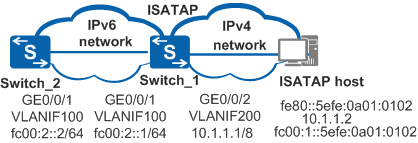Example for Configuring an ISATAP Tunnel
Networking Requirements
Figure 1 shows how an IPv6 host on the IPv4 network needs to connect to the IPv6 network through a border device. The IPv6 host and border device support ISATAP, so an ISATAP tunnel can be set up between the IPv6 host and the border device.
Configuration Roadmap
The configuration roadmap is as follows:
Configure an IPv4/IPv6 dual stack on Switch_1 so that Switch_1 can access the IPv4 and IPv6 networks.
Configure an ISATAP tunnel on Switch_1 so that IPv6 hosts on the IPv4 network can communicate with Switch_2 on the IPv6 network.
Configure a static route from Switch_2 to the ISATAP host.
Procedure
- Configure the ISATAP border device.
# Enable the service loopback function on an Eth-Trunk.

The interface must be idle and not transmitting services.
After the service loopback function is enabled on the Eth-Trunk, the physical interface added to the Eth-Trunk must be in the Up state. Otherwise, the link layer protocol of the tunnel interface cannot run properly.
<HUAWEI> system-view [HUAWEI] sysname Switch_1 [Switch_1] interface eth-trunk 1 [Switch_1-Eth-Trunk1] service type tunnel [Switch_1-Eth-Trunk1] quit [Switch_1] interface gigabitethernet 0/0/3 [Switch_1-GigabitEthernet0/0/3] eth-trunk 1 [Switch_1-GigabitEthernet0/0/3] quit
# Enable the IPv4/IPv6 dual stack and configure an IP address for each interface.
[Switch_1] ipv6 [Switch_1] vlan batch 100 200 [Switch_1] interface gigabitethernet 0/0/1 [Switch_1-GigabitEthernet0/0/1] port link-type hybrid [Switch_1-GigabitEthernet0/0/1] port hybrid pvid vlan 100 [Switch_1-GigabitEthernet0/0/1] port hybrid untagged vlan 100 [Switch_1-GigabitEthernet0/0/1] quit [Switch_1] interface gigabitethernet 0/0/2 [Switch_1-GigabitEthernet0/0/2] port link-type hybrid [Switch_1-GigabitEthernet0/0/2] port hybrid pvid vlan 200 [Switch_1-GigabitEthernet0/0/2] port hybrid untagged vlan 200 [Switch_1-GigabitEthernet0/0/2] quit [Switch_1] interface vlanif 100 [Switch_1-Vlanif100] ipv6 enable [Switch_1-Vlanif100] ipv6 address fc00:2::1/64 [Switch_1-Vlanif100] quit [Switch_1] interface vlanif 200 [Switch_1-Vlanif200] ip address 10.1.1.1 255.0.0.0 [Switch_1-Vlanif200] quit
# Configure an ISATAP tunnel.
[Switch_1] interface tunnel 1 [Switch_1-Tunnel1] tunnel-protocol ipv6-ipv4 isatap [Switch_1-Tunnel1] eth-trunk 1 [Switch_1-Tunnel1] ipv6 enable [Switch_1-Tunnel1] ipv6 address fc00:1::/64 eui-64 [Switch_1-Tunnel1] source vlanif 200 [Switch_1-Tunnel1] undo ipv6 nd ra halt [Switch_1-Tunnel1] quit
- Configure the ISATAP host.
# Run the following command to add a static route to the border device. The IPv4 address of the host is 10.1.1.2/8.
C:\> netsh interface ipv6 isatap set router 10.1.1.1 C:\> netsh netsh> interface netsh interface> ipv6 netsh interface ipv6>isatap netsh interface ipv6 isatap>set router 10.1.1.1 enabled 1440
- Configure Switch_2.
# Configure the IPv6 address for the interface.
<HUAWEI> system-view [HUAWEI] sysname Switch_2 [Switch_2] ipv6 [Switch_2] vlan batch 100 [Switch_2] interface gigabitethernet 0/0/1 [Switch_2-GigabitEthernet0/0/1] port link-type hybrid [Switch_2-GigabitEthernet0/0/1] port hybrid pvid vlan 100 [Switch_2-GigabitEthernet0/0/1] port hybrid untagged vlan 100 [Switch_2-GigabitEthernet0/0/1] quit [Switch_2] interface vlanif 100 [Switch_2-Vlanif100] ipv6 enable [Switch_2-Vlanif100] ipv6 address fc00:2::2/64 [Switch_2-Vlanif100] quit
# Configure a static route.
[Switch_2] ipv6 route-static fc00:1:: 64 fc00:2::1
- Verify the configuration.
# Check the IPv6 status of Tunnel1 on the ISATAP device.
[Switch_1] display ipv6 interface tunnel 1 Tunnel1 current state : UP IPv6 protocol current state : UP IPv6 is enabled, link-local address is FE80::5EFE:A01:101 Global unicast address(es): FC00:1::5EFE:A01:101, subnet is FC00:1::/64 Joined group address(es): FF02::1:FF01:101 FF02::2 FF02::1 MTU is 1500 bytes ND reachable time is 30000 milliseconds ND retransmit interval is 1000 milliseconds ND stale time is 1200 seconds ND advertised reachable time is 0 milliseconds ND advertised retransmit interval is 0 milliseconds ND router advertisement max interval 600 seconds, min interval 200 seconds ND router advertisements live for 1800 seconds ND router advertisements hop-limit 64 ND default router preference medium Hosts use stateless autoconfig for addresses
You can see that the tunnel status is Up.
# Ping the global unicast address of the tunnel interface on the ISATAP host from the ISATAP device.
[Switch_1] ping ipv6 FC00:1::5EFE:10.1.1.2 PING FC00:1::5EFE:10.1.1.2 : 56 data bytes, press CTRL_C to break Reply from FC00:1::5EFE:A01:102 bytes=56 Sequence=1 hop limit=64 time = 4 ms Reply from FC00:1::5EFE:A01:102 bytes=56 Sequence=2 hop limit=64 time = 3 ms Reply from FC00:1::5EFE:A01:102 bytes=56 Sequence=3 hop limit=64 time = 2 ms Reply from FC00:1::5EFE:A01:102 bytes=56 Sequence=4 hop limit=64 time = 2 ms Reply from FC00:1::5EFE:A01:102 bytes=56 Sequence=5 hop limit=64 time = 2 ms --- FC00:1::5EFE:10.1.1.2 ping statistics --- 5 packet(s) transmitted 5 packet(s) received 0.00% packet loss round-trip min/avg/max = 2/2/4 ms# Ping the global unicast address of the ISATAP device from the ISATAP host.
C:\> ping fc00:1::5efe:10.1.1.1 Pinging fc00:1::5efe:10.1.1.1 from fc00:1::5efe:10.1.1.2 with 32 bytes of data: Reply from fc00:1::5efe:10.1.1.1: time=1ms Reply from fc00:1::5efe:10.1.1.1: time=1ms Reply from fc00:1::5efe:10.1.1.1: time=1ms Reply from fc00:1::5efe:10.1.1.1: time=1ms Ping statistics for fc00:1::5efe:10.1.1.1: Packets: Sent = 4, Received = 4, Lost = 0 (0% loss), Approximate round trip times in milli-seconds: Minimum = 1ms, Maximum = 1ms, Average = 1ms# Ping the global unicast address of the tunnel interface on the ISATAP host from Switch_2.
[Switch_2] ping ipv6 FC00:1::5EFE:10.1.1.2 PING FC00:1::5EFE:10.1.1.2 : 56 data bytes, press CTRL_C to break Reply from FC00:1::5EFE:A01:102 bytes=56 Sequence=1 hop limit=64 time = 4 ms Reply from FC00:1::5EFE:A01:102 bytes=56 Sequence=2 hop limit=64 time = 3 ms Reply from FC00:1::5EFE:A01:102 bytes=56 Sequence=3 hop limit=64 time = 2 ms Reply from FC00:1::5EFE:A01:102 bytes=56 Sequence=4 hop limit=64 time = 2 ms Reply from FC00:1::5EFE:A01:102 bytes=56 Sequence=5 hop limit=64 time = 2 ms --- FC00:1::5EFE:10.1.1.2 ping statistics --- 5 packet(s) transmitted 5 packet(s) received 0.00% packet loss round-trip min/avg/max = 2/2/4 ms
Configuration Files
Switch_1 configuration file
# sysname Switch_1 # ipv6 # vlan batch 100 200 # interface Vlanif100 ipv6 enable ipv6 address FC00:2::1/64 # interface Vlanif200 ip address 10.1.1.1 255.0.0.0 # interface Eth-Trunk1 service type tunnel # interface GigabitEthernet0/0/1 port link-type hybrid port hybrid pvid vlan 100 port hybrid untagged vlan 100 # interface GigabitEthernet0/0/2 port link-type hybrid port hybrid pvid vlan 200 port hybrid untagged vlan 200 # interface GigabitEthernet0/0/3 eth-trunk 1 # interface Tunnel1 ipv6 enable ipv6 address FC00:1::/64 eui-64 undo ipv6 nd ra halt tunnel-protocol ipv6-ipv4 isatap source Vlanif200 eth-trunk 1 # return
Switch_2 configuration file
# sysname Switch_2 # ipv6 # vlan batch 100 # interface Vlanif100 ipv6 enable ipv6 address FC00:2::2/64 # interface GigabitEthernet0/0/1 port link-type hybrid port hybrid pvid vlan 100 port hybrid untagged vlan 100 # ipv6 route-static FC00:1:: 64 FC00:2::1 # return
